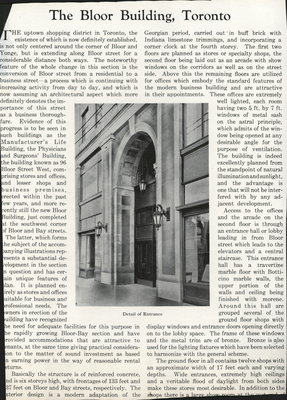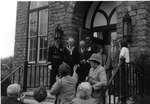The Bloor Building, Toronto
- Full Text
THE BLOOR BUILDING, TORONTO
===========================
The uptown shopping district in Toronto, the existence of which is now definitely established, is not only centered around the corner of Bloor and Yonge, but is extending along Bloor street for a considerable distance both ways. The noteworthy feature of the whole change in this section is the conversion of Bloor street from a residential to a business street—a process which is continuing with increasing activity from day to day, and which is now assuming an architectural aspect which more definitely denotes the importance of this street as a business thoroughfare.
Evidence of this progress is to be seen in such buildings as the Manufacturer's Life Building, the Physicians and Surgeons' Building, the building known as 96 Bloor Street West, comprising stores and offices, and lesser shops and business premises, erected within the past few years, and more recently still the new Bloor Building, just completed it the southwest corner of Bloor and Bay streets.
The latter, which forms the subject of the accompanying illustrations represents a substantial development in the section n question and has certain unique features of an. It is planned entirely as stores and offices suitable for business and professional needs. The owners in erection of the building have recognized the need for adequate facilities for this purpose in the rapidly growing Bloor-Bay section and have provided accommodations that are attractive to tenants, at the same time giving practical consideration to the matter of sound investment as based on earning power in the way of reasonable rental turns.
Basically the structure is of reinforced concrete, and is six storeys high, with frontages of 133 feet and 137 feet on Bloor and Bay streets, respectively. The exterior design is a modern adaptation of the
Georgian period, carried out in buff brick with Indiana limestone trimmings, and incorporating a corner clock at the fourth storey. The first two floors are planned as stores or specialty shops, the second floor being laid out as an arcade with show windows on the corridors as well as on the street side. Above this the remaining floors are utilized for offices which embody the standard features of the modern business building and are attractive in their appointments. These offices are extremely well lighted, each room having two 5 ft. by 7 ft. windows of metal sash on the astral principle, which admits of the window being opened at any desirable angle for the purpose of ventilation. The building is indeed excellently planned from the standpoint of natural illumination and sunlight, and the advantage is one that will not be interfered with by any adjacent development.
Access to the offices and the arcade on the second floor is through an entrance hall or lobby leading in from Bloor street which leads to the elevators and a central staircase. This entrance hall has a travertine marble floor with Botticino marble walls, the upper portion of the walls and ceiling being finished with morene. Around this hall are grouped several of the ground floor shops with display windows and entrance doors opening directly on to the lobby space. The frame of these windows and the metal trim are of bronze. Bronze is also used for the lighting fixtures which have been selected to harmonize with the general scheme.
The ground floor in all contains twelve shops with an approximate width of 17 feet each and varying depths. Wide entrances, extremely high ceilings and a veritable flood of daylight from both sides make these stores most desirable. In addition to the shops there is a large show room in east end the ground floor which is suitable as an automobile salesroom, or for any other business where large display space is required.
The various shops on ground and first floor as well as the offices and corridors in general are trimmed with birch, finished with a walnut stain, and the walls are of pleasing and harmonizing tint. The floors throughout are of linoleum laid directly on the concrete, with the exception of the corridor floors which are of terrazo. The column spacing as is typical in modern office buildings today gives a flexibility of plan in the matter of divisions or partitions to allow for practically any size office desirable.
The wiring system has also been planned on a flexible principle which enables telephones, wiring, etc., to be conveniently placed.
In addition to the stores and offices a well lighted basement extends the full area of the building. The latter is absolutely watertight and is planned for rental purposes, being suitable to cafeteria, bowling alley and other uses. This part of the building also contains the boiler and machinery rooms. The building is heated by a two-pipe vacuum system, and the plumbing and similar equipment throughout is of approved modern type.
===========================
- Media Type
- Text
- Image
- Newspaper
- Item Types
- Architectural drawings
- Clippings
- Articles
- Description
- Article about the Bloor Building designed by N. A. Armstrong Co., Ltd., and located at Bloor Street West at Bay Street; with 3 black and white photographs of:
Detail of Entrance;
Second Floor Shops showing Corridor Display Window;
Entrance hall.
Also two architectural drawings by N.A. Armstrong Company Ltd.
Two newspaper clippings with photographs; one measures 26.5 x 18.5 cm. Unknown publication.
From Armstrong family collection. - Notes
- ARMSTRONG, Norman Alexander (1882-1957) was a prolific designer of residential and commercial buildings in the Toronto area. Born in Queenston, Ont. on 2 September 1882 he attended public and high schools in Niagara Falls and gained his knowledge of architecture with the Toronto architect J.W. Siddall.
Upon his return from United States to Toronto in 1919 he opened his own office called the N.A. Armstrong Company Ltd., specializing in engineering and architectural projects. Throughout the 1920's and 1930's Armstrong adapted to changing tastes in design as he offered his residential clients a variety of schemes in Tudor, Colonial or Georgian Revival styles.
An exceptional yet underrated work from this period is the International Harvester Co. Showroom, Bathurst Street, Toronto (1939), with its refined detailing executed in brick, art stone and plate glass.
Active until the early 1950's Armstrong turned over much of the work in his office to his son William G., and died at Toronto on 4 May 1957.
SOURCE (and more on his projects): http://dictionaryofarchitectsincanada.org/node/58
- Place of Publication
- Toronto, Ontario
- Date of Publication
- 1927
- Subject(s)
- Personal Name(s)
- Norman Alexander Armstrong
- Local identifier
- QC00632
- Language of Item
- English
- Geographic Coverage
-
-
Ontario, Canada
Latitude: 43.60012 Longitude: -79.66632
-
- Copyright Statement
- Copyright status unknown. Responsibility for determining the copyright status and any use rests exclusively with the user.
- Contact
- Niagara-on-the-Lake Public LibraryEmail:localhistory@notlpl.org
Website
Agency street/mail address:10 Anderson Lane P.O. Box 430
Niagara-on-the-Lake, ON L0S 1J0
905-468-2023




